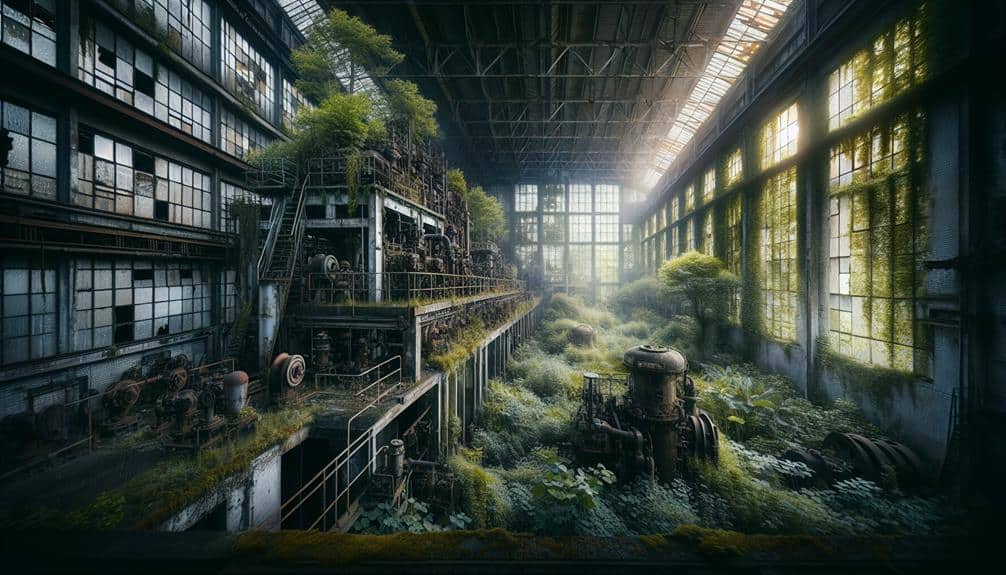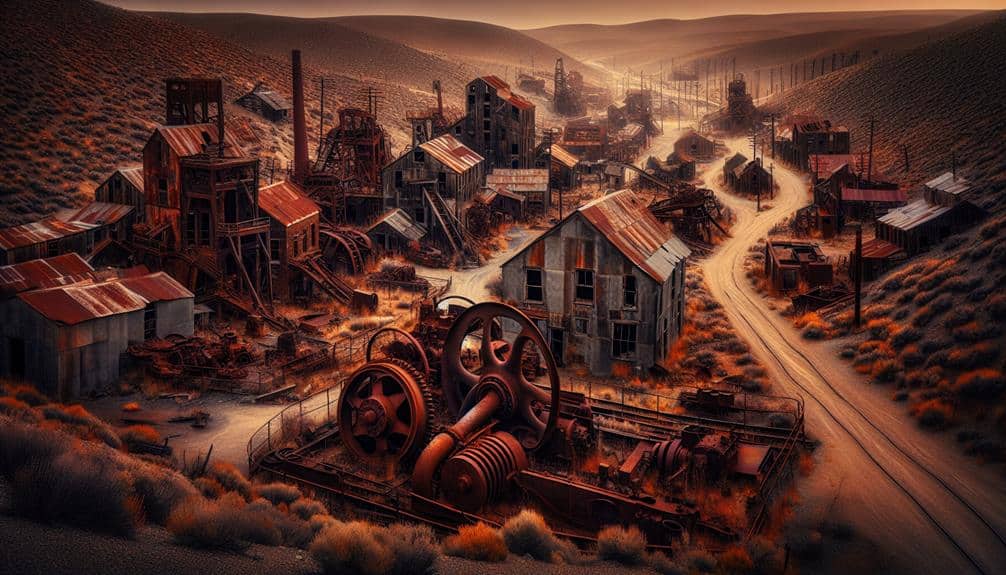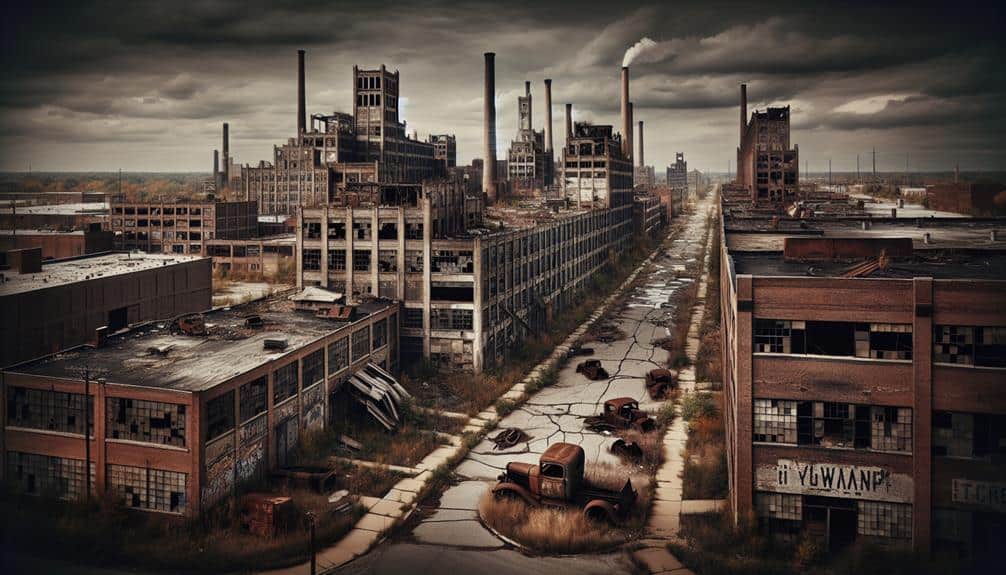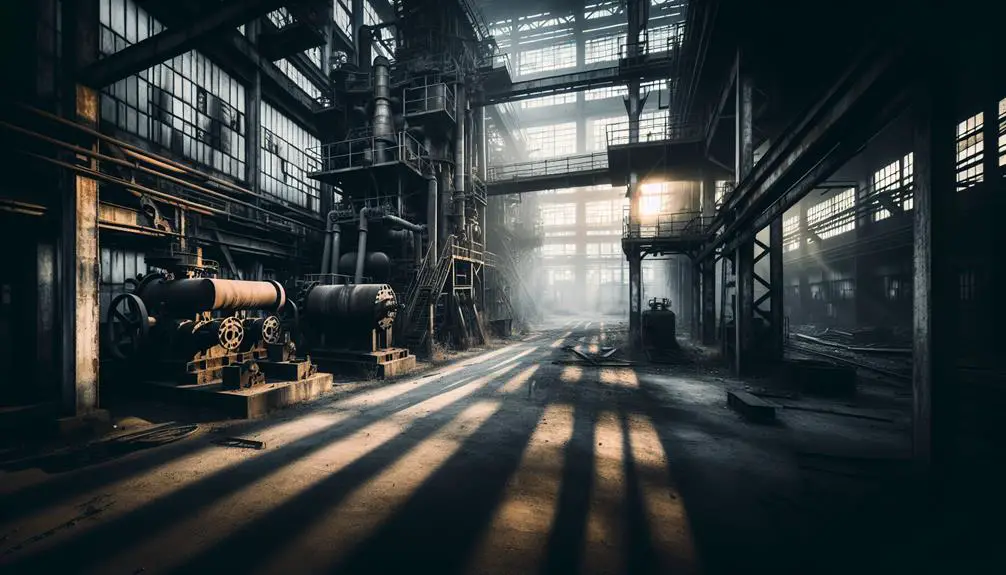Immerse yourself in the haunting remains of forgotten industrial glory in the US. Explore the vacant streets and decaying structures of once-thriving ghost towns, revealing a sobering proof to the nation's industrial decline. Discover Centralia's tragic tale of a coal mine fire that still burns underground. Witness Gary, Indiana's abandoned factories and homes, a legacy of economic downturn. Uncover Braddock's desolate streets, echoing its steel town past. Venture into Picher's empty roads, scarred by extensive mining. Visit Lowell, Arizona, where boarded-up shops narrate the loss of prosperity. Each town tells a unique story of industrial demise worth exploring further.
Key Points
- Centralia, Pennsylvania: coal mine fire led to uninhabitable conditions due to toxic gases.
- Gary, Indiana: economic downturn caused mass abandonment, leaving behind empty factories and homes.
- Braddock, Pennsylvania: abandoned factories and urban decay reflect economic decline.
- Picher, Oklahoma: extensive mining led to a ghost town with abandoned structures.
- Lowell, Arizona: once vibrant mining town now displays economic decline through desolation.
Rise and Fall of Centralia
The once thriving town of Centralia in Pennsylvania experienced a drastic decline due to a coal mine fire that has been burning underground since 1962. This underground mine fire, which initially started as a landfill fire that spread to an unsealed coal seam, has been the primary reason for the town's demise. The coal fire caused unsafe levels of carbon monoxide and other toxic gases to seep into the town, leading to health hazards and making the area uninhabitable. Despite efforts to extinguish the fire, including various techniques like excavation and capping, the fire continues to burn to this day, serving as a haunting reminder of Centralia's industrial past.
The underground mine fire not only posed immediate dangers to residents but also significantly impacted the town's economy. With the evacuation and demolition of homes, businesses, and infrastructure, Centralia's vibrant community was torn apart, leaving behind a desolate landscape. The legacy of the coal fire serves as a cautionary tale of the environmental and social costs associated with industrial activities, prompting reflection on the delicate balance between progress and preservation.
Abandoned Steel Town: Gary, Indiana
Amidst the haunting echoes of industrial decline resonating from Centralia's coal fire tragedy, the abandoned steel town of Gary, Indiana emerges as another stark reminder of the once-thriving industrial centers that have succumbed to abandonment and decay. Once a bustling hub of steel production, Gary now stands as a testimony to urban decay and economic downturn.
The story of Gary, Indiana is one of rapid rise and even faster decline. Founded in 1906, the town experienced a boom during the early 20th century as a major steel producer. However, as the steel industry began to falter in the late 20th century, Gary faced a rapid economic downturn, leading to massive job losses and a subsequent exodus of residents.
Today, Gary's landscape is dotted with abandoned factories, overgrown lots, and boarded-up homes, painting a picture of a town that has been left to crumble. The once vibrant streets now stand eerily quiet, with only the echoes of past prosperity lingering in the air. As you wander through the remnants of this once-thriving industrial center, you can't help but feel the weight of its forgotten glory and the impact of economic upheaval on a community that now lies in ruins.
Quiet Remnants of Braddock
Quietly nestled amidst the shadows of its former industrial prowess, the remnants of Braddock tell a somber tale of economic decline and resilience. Once a bustling steel town in Pennsylvania, Braddock now stands as a forgotten piece of history, its abandoned factories and empty streets bearing witness to the shifts in the American economy. Urban exploration enthusiasts are drawn to Braddock's quiet remnants, keen to uncover the stories hidden within its decaying structures and deserted landscapes.
Walking through Braddock today, you can almost hear the echoes of a bygone era when the steel industry fueled the town's prosperity. The rusted remnants of steel mills serve as a stark reminder of the once-thriving industrial hub that now lies in disarray. Despite its desolate appearance, Braddock's spirit endures, reflected in the efforts of its remaining residents to preserve the town's heritage amidst the urban decay.
As you navigate the forgotten history of Braddock, you can't help but feel a sense of reverence for the resilience of a community that has weathered the storms of economic upheaval. These quiet remnants serve as a poignant reminder of the rise and fall of industrial America, inviting you to explore the layers of history buried within Braddock's silent streets.
The Empty Streets of Picher
Nestled within the heart of economic decline, Picher's streets now stand hauntingly empty, echoing a tragic tale of abandonment and loss. Once a bustling mining town in Oklahoma, Picher's landscape is now marred by rusting ruins and the remnants of a toxic wasteland. The legacy of extensive lead and zinc mining has left a devastating mark on this community, leading to its ultimate demise.
As you walk through the desolate streets of Picher, you can't help but feel the weight of its history bearing down on you. The abandoned homes and businesses serve as a stark reminder of the human cost of industrial decline. The eerie silence that engulfs the town speaks volumes about the impact of environmental degradation and economic collapse.
While nature is slowly reclaiming the land, the scars of Picher's past remain deeply etched in its surroundings. The empty streets serve as a poignant symbol of a once-thriving community now reduced to a ghost town, a cautionary tale of the consequences of unchecked industrialization.
Lost Prosperity: Lowell, Arizona
Once a vibrant mining town in Arizona, the streets of Lowell now bear witness to the profound impact of economic decline and lost prosperity. The town, once bustling with activity, now stands as a shadow of its former self, with empty storefronts lining the main street and desolate landscapes surrounding the outskirts. To paint a clearer picture, consider the following:
- Boarded-Up Shops: Many once-thriving businesses now sit abandoned, their windows covered in dust and boards.
- Rusty Mining Equipment: Remnants of the town's mining history lay scattered around, rusting under the harsh desert sun.
- Closed Community Center: The heart of the town, the community center, now stands silent and locked, a stark reminder of the community's dwindling spirit.
- Overgrown Streets: Nature is slowly reclaiming the town, with weeds pushing through the cracks in the pavement, giving the streets an unkempt appearance.
The story of Lowell serves as a poignant example of how the tides of prosperity can shift, leaving behind only echoes of a once-thriving community.
Frequently Asked Questions
What Led to the Ultimate Decline and Abandonment of These Ghost Towns?
You witnessed economic downturns and urban decay causing the demise of these ghost towns. Industries collapsed, jobs vanished, and people fled, leaving once-thriving communities deserted. The abandoned structures now stand as eerie reminders of a bygone era.
Are There Any Efforts Being Made to Preserve or Revitalize These Abandoned Areas?
Efforts to conserve and revitalize abandoned areas are essential. Preservation projects restore historical significance, while revitalization initiatives spark economic growth. By investing in these ghost towns, you can revive the past and build for the future.
What Impact Did the Closure of Industries Have on the Surrounding Communities?
The closure of industries brought economic devastation to communities. Jobs vanished, businesses shuttered, and hope dwindled. Yet, amidst this turmoil, community resilience emerged. People banded together, seeking new paths, rebuilding, and redefining their futures.
How Have These Ghost Towns Been Portrayed in Popular Culture or Media?
In popular culture and media, ghost towns are often romanticized as symbols of abandonment and mystery. Movies often exaggerate the desolation, focusing on eerie landscapes and forgotten relics, rather than historical accuracy.
What Challenges Do Historians Face in Researching and Documenting the History of These Forgotten Industrial Towns?
When researching history of forgotten industrial towns, challenges arise in documenting details due to sparse records, shifting landscapes, and fading memories. Industrial decline complicates research, demanding creative approaches to piece together narratives.



